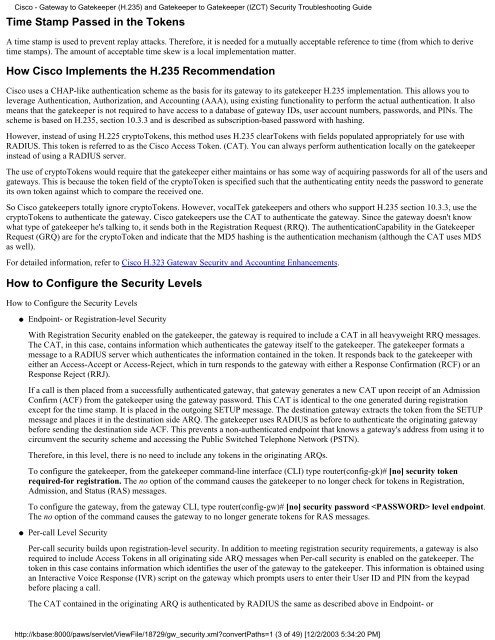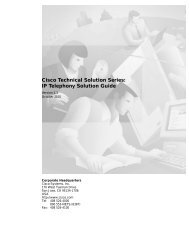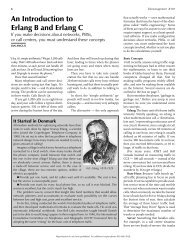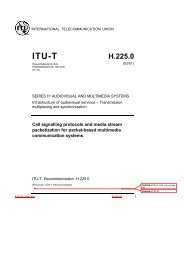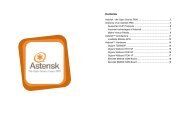Cisco - Gateway to Gatekeeper (H.235) and ... - VOIP Information
Cisco - Gateway to Gatekeeper (H.235) and ... - VOIP Information
Cisco - Gateway to Gatekeeper (H.235) and ... - VOIP Information
You also want an ePaper? Increase the reach of your titles
YUMPU automatically turns print PDFs into web optimized ePapers that Google loves.
<strong>Cisco</strong> - <strong>Gateway</strong> <strong>to</strong> <strong>Gatekeeper</strong> (<strong>H.235</strong>) <strong>and</strong> <strong>Gatekeeper</strong> <strong>to</strong> <strong>Gatekeeper</strong> (IZCT) Security Troubleshooting GuideTime Stamp Passed in the TokensA time stamp is used <strong>to</strong> prevent replay attacks. Therefore, it is needed for a mutually acceptable reference <strong>to</strong> time (from which <strong>to</strong> derivetime stamps). The amount of acceptable time skew is a local implementation matter.How <strong>Cisco</strong> Implements the <strong>H.235</strong> Recommendation<strong>Cisco</strong> uses a CHAP-like authentication scheme as the basis for its gateway <strong>to</strong> its gatekeeper <strong>H.235</strong> implementation. This allows you <strong>to</strong>leverage Authentication, Authorization, <strong>and</strong> Accounting (AAA), using existing functionality <strong>to</strong> perform the actual authentication. It alsomeans that the gatekeeper is not required <strong>to</strong> have access <strong>to</strong> a database of gateway IDs, user account numbers, passwords, <strong>and</strong> PINs. Thescheme is based on <strong>H.235</strong>, section 10.3.3 <strong>and</strong> is described as subscription-based password with hashing.However, instead of using H.225 cryp<strong>to</strong>Tokens, this method uses <strong>H.235</strong> clearTokens with fields populated appropriately for use withRADIUS. This <strong>to</strong>ken is referred <strong>to</strong> as the <strong>Cisco</strong> Access Token. (CAT). You can always perform authentication locally on the gatekeeperinstead of using a RADIUS server.The use of cryp<strong>to</strong>Tokens would require that the gatekeeper either maintains or has some way of acquiring passwords for all of the users <strong>and</strong>gateways. This is because the <strong>to</strong>ken field of the cryp<strong>to</strong>Token is specified such that the authenticating entity needs the password <strong>to</strong> generateits own <strong>to</strong>ken against which <strong>to</strong> compare the received one.So <strong>Cisco</strong> gatekeepers <strong>to</strong>tally ignore cryp<strong>to</strong>Tokens. However, vocalTek gatekeepers <strong>and</strong> others who support <strong>H.235</strong> section 10.3.3, use thecryp<strong>to</strong>Tokens <strong>to</strong> authenticate the gateway. <strong>Cisco</strong> gatekeepers use the CAT <strong>to</strong> authenticate the gateway. Since the gateway doesn't knowwhat type of gatekeeper he's talking <strong>to</strong>, it sends both in the Registration Request (RRQ). The authenticationCapability in the <strong>Gatekeeper</strong>Request (GRQ) are for the cryp<strong>to</strong>Token <strong>and</strong> indicate that the MD5 hashing is the authentication mechanism (although the CAT uses MD5as well).For detailed information, refer <strong>to</strong> <strong>Cisco</strong> H.323 <strong>Gateway</strong> Security <strong>and</strong> Accounting Enhancements.How <strong>to</strong> Configure the Security LevelsHow <strong>to</strong> Configure the Security Levels●●Endpoint- or Registration-level SecurityWith Registration Security enabled on the gatekeeper, the gateway is required <strong>to</strong> include a CAT in all heavyweight RRQ messages.The CAT, in this case, contains information which authenticates the gateway itself <strong>to</strong> the gatekeeper. The gatekeeper formats amessage <strong>to</strong> a RADIUS server which authenticates the information contained in the <strong>to</strong>ken. It responds back <strong>to</strong> the gatekeeper witheither an Access-Accept or Access-Reject, which in turn responds <strong>to</strong> the gateway with either a Response Confirmation (RCF) or anResponse Reject (RRJ).If a call is then placed from a successfully authenticated gateway, that gateway generates a new CAT upon receipt of an AdmissionConfirm (ACF) from the gatekeeper using the gateway password. This CAT is identical <strong>to</strong> the one generated during registrationexcept for the time stamp. It is placed in the outgoing SETUP message. The destination gateway extracts the <strong>to</strong>ken from the SETUPmessage <strong>and</strong> places it in the destination side ARQ. The gatekeeper uses RADIUS as before <strong>to</strong> authenticate the originating gatewaybefore sending the destination side ACF. This prevents a non-authenticated endpoint that knows a gateway's address from using it <strong>to</strong>circumvent the security scheme <strong>and</strong> accessing the Public Switched Telephone Network (PSTN).Therefore, in this level, there is no need <strong>to</strong> include any <strong>to</strong>kens in the originating ARQs.To configure the gatekeeper, from the gatekeeper comm<strong>and</strong>-line interface (CLI) type router(config-gk)# [no] security <strong>to</strong>kenrequired-for registration. The no option of the comm<strong>and</strong> causes the gatekeeper <strong>to</strong> no longer check for <strong>to</strong>kens in Registration,Admission, <strong>and</strong> Status (RAS) messages.To configure the gateway, from the gateway CLI, type router(config-gw)# [no] security password level endpoint.The no option of the comm<strong>and</strong> causes the gateway <strong>to</strong> no longer generate <strong>to</strong>kens for RAS messages.Per-call Level SecurityPer-call security builds upon registration-level security. In addition <strong>to</strong> meeting registration security requirements, a gateway is alsorequired <strong>to</strong> include Access Tokens in all originating side ARQ messages when Per-call security is enabled on the gatekeeper. The<strong>to</strong>ken in this case contains information which identifies the user of the gateway <strong>to</strong> the gatekeeper. This information is obtained usingan Interactive Voice Response (IVR) script on the gateway which prompts users <strong>to</strong> enter their User ID <strong>and</strong> PIN from the keypadbefore placing a call.The CAT contained in the originating ARQ is authenticated by RADIUS the same as described above in Endpoint- orhttp://kbase:8000/paws/servlet/ViewFile/18729/gw_security.xml?convertPaths=1 (3 of 49) [12/2/2003 5:34:20 PM]


